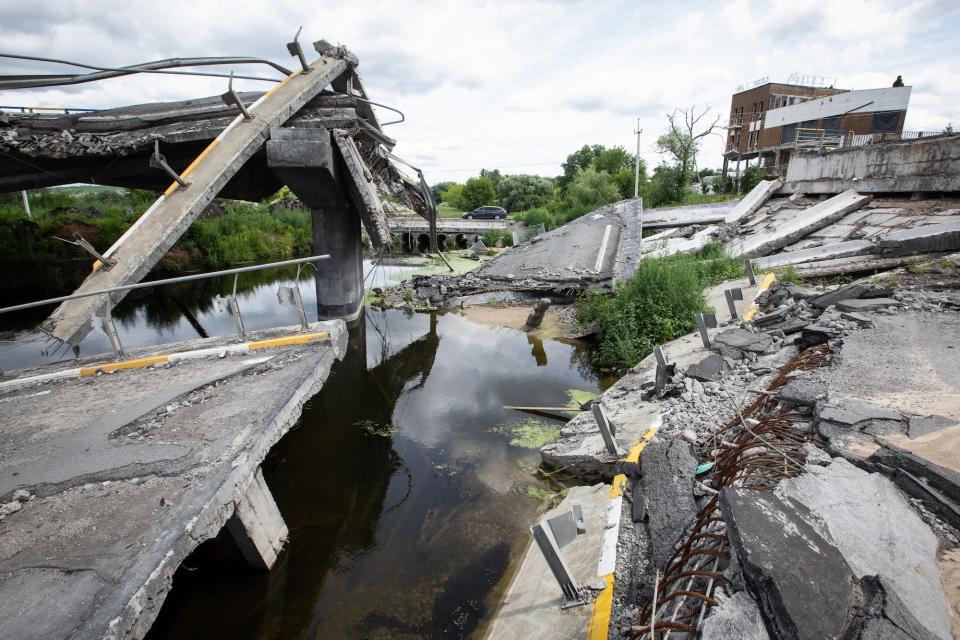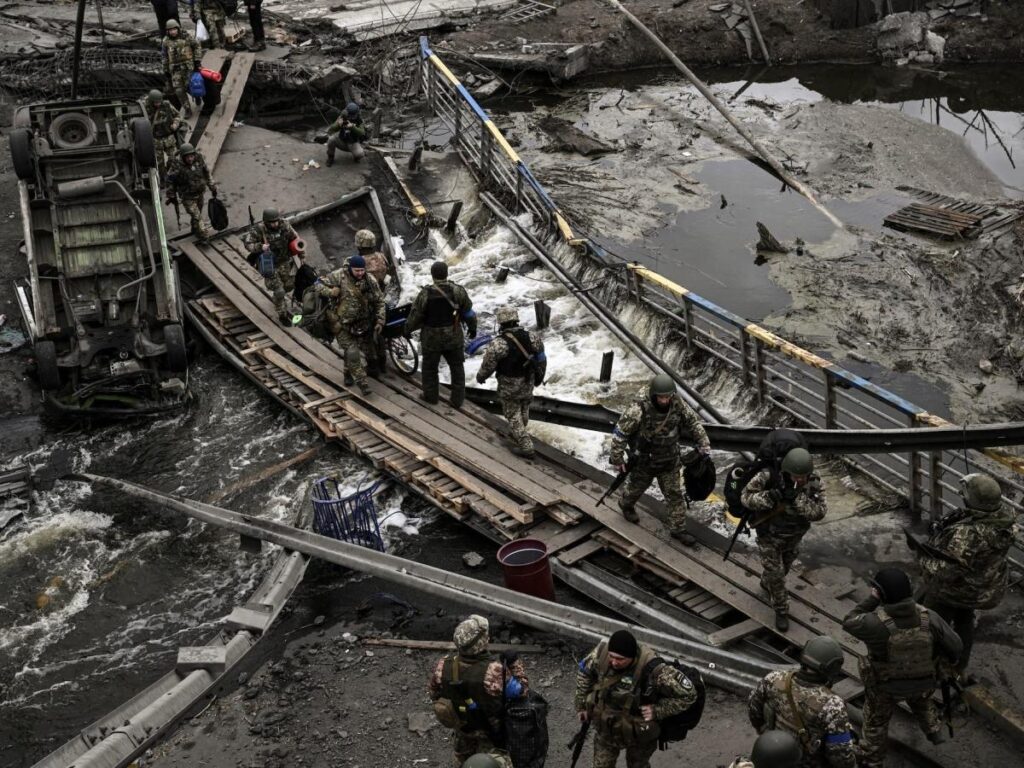-
Ukraine narrowly won the Battle of Irpin in the early days of the war.
-
The Russian attack on Kiev was a surprise and Ukraine’s defenses near the capital were thin.
-
A businessman proposed a plan that would help slow Russia’s advance.
Russia came dangerously close to capturing Kiev in the early days of the war in Ukraine. But an exhausted Ukrainian army brigade, hastily mobilized volunteers and a businessman who blew up a dam saved the city – and Ukraine from losing the war.
That is the conclusion of American and British experts who investigated the fighting along the Irpin River northwest of Kiev. Based on extensive interviews with Ukrainians who fought at the Irpin, they describe an epic battle won by the narrowest of margins.
“The Battle of the Irpin River was a close-up,” wrote Richard Sladden, Liam Collins and Alfred Connable in an article in British Army Reviewa British military magazine.
The story begins on February 24, 2022, when Russia invaded Ukraine. Paratroopers in helicopters launched an airstrike to capture Hostomel airport, aiming for a air head that would allow large transport planes to bring in the reinforcements and heavy weapons needed to capture nearby Kiev.
At the same time, Russian armored columns stationed in Belarus, on Ukraine’s northern border, advanced south, aiming to capture Kiev. One Russian attack group advanced along the eastern bank of the Dnipro River, and the other along the western bank.
This left the Ukrainian troops dangerously out of position. “The Russian attack on Kiev from the northwest was a shock but not a surprise,” the British Army Review article said. “Ukrainian commanders had to make difficult choices about resource allocation. An attack on Kiev from Belarus was the most dangerous course of enemy action, but because it was daring it was also considered the least likely. An attack in eastern and southern Ukraine was the most dangerous. likely course of action, which is why the Ukrainian forces were deployed against this in the first place.
The Ukrainian 72nd Mechanized Brigade was thus one of the few units left to defend Kiev. Even then, the brigade was primarily positioned to stop an attack on Kiev from the east. The exact strength of the 72nd is not clear, but a full-strength Ukrainian brigade could number about 3,000 men – and the 72nd was far from full strength. Many soldiers were armed with only rifles, supported by a few armored vehicles, anti-tank missiles and cannons, and multiple rocket launchers.
They faced a Russian force consisting of roughly 10,000 soldiers, well equipped with tanks, infantry fighting vehicles and artillery. This should have made it easy for the Russian column on the west bank of the Dnipro to quickly reach Hostomel Airport – also known as Antonov Airport, just 130 kilometers away – to link up with the paratroopers and then head southeast to to advance in Kiev. But to reach Kiev they would have to cross the Irpin River, a tributary that runs through the city’s outskirts and flows into a dam at the Kiev Reservoir.
“The defense line around Kiev was thin,” the article said. “The 5th company of the 72nd Brigade was deployed with only 22 soldiers. Numbers increased during the first days of the invasion as newly mobilized troops arrived, but the company and many of its sister units were consistently underpowered compared to the Russian units across the (Irpin) That the bridges along the river on the morning were not destroyed by the invasion, almost cost Ukraine its capital.’
In many ways the Russian plan was similar Operation Market Garden in 1944, a daring plan emerged to use American and British paratroopers to capture bridges over several rivers in the Netherlands, creating a corridor for British armored divisions to cross the Rhine and into Germany.
Market Garden turned out to be ‘a bridge too far’, doomed by sloppy planning, rough terrain, lack of aggressiveness of Allied tanks and unexpectedly strong German resistance. Then, as now, paratroopers were a shock force lacking the armor, heavy artillery, and supplies needed to dislodge fortified positions. The same problems affected the Russian attack on Kiev.
To begin with, the Russian paratroopers failed to conquer Hostomel airport against determined Ukrainian resistance, during which several helicopters were shot down; There were 1,000 Russian reinforcements in a fleet of 18 transport aircraft turned awaypossibly due to concerns that they would be taken down. It was not until February 25 that the westernmost ground column secured the airport, after which the Ukrainians had made the runways unusable.
Meanwhile, a Kievan businessman named Andriy (a pseudonym) realized that blowing up the dam 14 miles north of Kiev would cause the Irpin to overflow its banks and slow the Russian advance. A hastily arranged meeting with Colonel General Oleksandr Syrskyi, then commander of the Ukrainian Ground Forces, yielded a pile of explosives and a technical officer. The result was the dumping of 31 billion liters of water into the Irpin, which limited Russian maneuvers.
Nevertheless, Russian forces could have ‘bounced’ the Irpin while the Ukrainian defenses were weak by using undamaged bridges or building their own pontoons. “The Russians could have easily crossed the Irpin if they had been more aggressive,” Liam Collins, a former US Special Forces officer and co-author of the article, told Business Insider. “They should have crossed on the 25th, as soon as the leading edge of the column reached the outskirts of the city. But since they had no plan to deal with the Ukrainian resistance, that stopped them completely and they had to stop and formulate the plan they had come up with. This should have already given the Ukrainians time to blow up the bridges, set up their defenses and mobilize.”
“The Russians believed they were going to enter the capital in what was essentially a parade formation and not a combat movement,” said Collins, who has advised the Ukrainian military. “So they had to completely regroup.”


Russian columns finally attempted to cross the Irpin in late February and early March. But it was too late. “Russian commanders had no choice but to press forward in linear columns with ill-prepared troops into still thin, but now much more robust and prepared defenses,” the British Army Review article said.
The crossing attempts were stopped by the 72nd Mechanized Brigade, some Ukrainian tanks and artillery, and hastily mobilized volunteers who learned on the spot how to operate their deadly Western-made Javelin and NLAW anti-tank missiles. “In my company, if a position had a spear, one soldier would dig a hole while the other watched a YouTube video on how to fire it,” one Ukrainian officer recalled.
These guided missiles and artillery destroyed Russian tanks and the perception of their impregnability.
At the end of March, Russian troops withdrew to the north. Had Russian tanks managed to cross the Irpin and enter Kiev, the war could have essentially ended in a Russian victory within the first week.
No plan survives contact with the enemy, and unexpected hiccups – what German military philosopher Carl von Clausewitz called the “friction of war” – inevitably disrupt the smartest strategies, which the attack in Kiev did not. Ukraine also showed a remarkable ability to quickly mobilize volunteers who proved effective.
Nevertheless, Collins blames the Russian failure on poor preparation. “It was 100 percent sloppy planning, lack of preparation and unexpected Ukrainian resistance that should have been anticipated,” Collins said. “The mechanized forces should have run through this minimal defense like a hot knife through butter.”
Michael Peck is a defense writer whose work has appeared in Forbes, Defense News, Foreign Policy magazine and other publications. He has an MA in Political Science from Rutgers Univ. Follow him further Tweet And LinkedIn.
Read the original article Business insider







